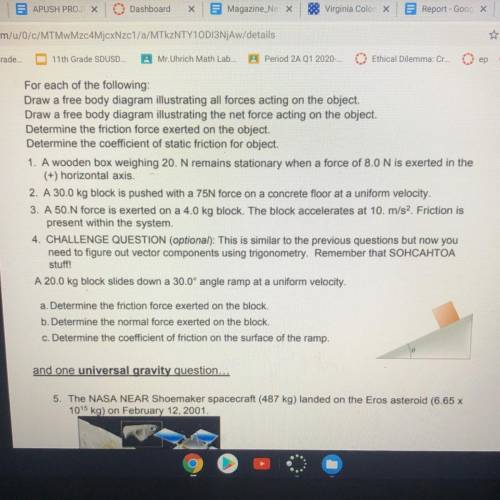
Physics, 18.10.2020 07:01 jasmineharris121
For each of the following:
Draw a free body diagram illustrating all forces acting on the object.
Draw a free body diagram illustrating the net force acting on the object.
Determine the friction force exerted on the object.
Determine the coefficient of static friction for object.
1. A wooden box weighing 20. N remains stationary when a force of 8.0 N is exerted in the
(+) horizontal axis.
2. A 30.0 kg block is pushed with a 75N force on a concrete floor at a uniform velocity.
3. A 50.N force is exerted on a 4.0 kg block. The block accelerates at 10. m/s2. Friction is
present within the system.
4. CHALLENGE QUESTION (optional): This is similar to the previous questions but now you
need to figure out vector components using trigonometry. Remember that SOHCAHTOA
stuff!
A 20.0 kg block slides down a 30.0° angle ramp at a uniform velocity.
a. Determine the friction force exerted on the block.
b. Determine the normal force exerted on the block.
c. Determine the coefficient of friction on the surface of the ramp.


Answers: 1
Another question on Physics

Physics, 21.06.2019 22:20
The place you get your hair cut has two nearly parallel mirrors 6.00 m apart. as you sit in the chair, your head is 2.00 m from the nearer mirror. looking toward this mirror, you first see your face and then, farther away, the back of your head. (the mirrors need to be slightly nonparallel for you to be able to see the back of your head, but you can treat them as parallel in this problem.) how far away does the back of your head appear to be?
Answers: 2

Physics, 21.06.2019 23:30
The pressure, volume, and temperature of a mole of an ideal gas are related by the equation pv = 8.31t, where p is measured in kilopascals, v in liters, and t in kelvins. use differentials to find the approximate change in the pressure if the volume increases from 14 l to 14.6 l and the temperature decreases from 375 k to 370 k. (round the answer to two decimal places.)
Answers: 3

Physics, 22.06.2019 07:30
Quantum mechanics applies to subatomic, atomic, nanometer-size, and micrometer-size systems. nanometer, micrometer, and kilometer-size systems. atomic, nanometer-size, and micrometer-size systems. subatomic, atomic, and nanometer-size systems.
Answers: 2

Physics, 22.06.2019 17:50
Which of the following best describes internal energy? a. the difference between the kinetic and potential energies of the particles in a system b. the sum of the kinetic and potential energies of the particles in a system c. the sum of the kinetic and thermal energies of the particles in a system d. the difference between the kinetic and thermal energies of the particles in a system
Answers: 2
You know the right answer?
For each of the following:
Draw a free body diagram illustrating all forces acting on the object.
Questions


Mathematics, 23.07.2021 05:50



Physics, 23.07.2021 05:50

Mathematics, 23.07.2021 05:50


Computers and Technology, 23.07.2021 05:50


Computers and Technology, 23.07.2021 05:50


Business, 23.07.2021 05:50


Mathematics, 23.07.2021 06:00


Business, 23.07.2021 06:00

Mathematics, 23.07.2021 06:00

Mathematics, 23.07.2021 06:00




